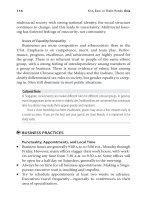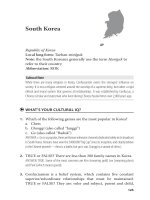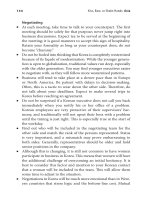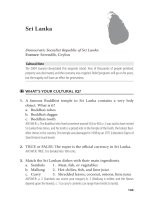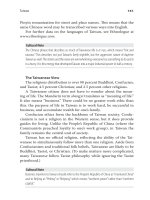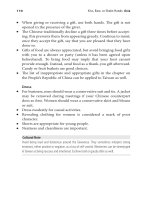Tài liệu How to Do Business in 12 Asian Countries 4 pdf
Bạn đang xem bản rút gọn của tài liệu. Xem và tải ngay bản đầy đủ của tài liệu tại đây (130.15 KB, 9 trang )
8 Kiss, Bow, or Shake Hands: Asia
Sources of Anxiety Reduction
e family, school, work unit, and local community are the basic
social structures that give stability to a person’s life. ere is a strong
commitment to the extended family. e state, rather than religion,
traditionally dictated the standards of wisdom, morality, and the
common good. Obedience to parents is integral to a sense of security
and stability. Maintaining harmony is vital.
Faith in the Communist Party, which rules the PRC, is abating. Some
Chinese look to other ideologies for solace, including native and Western
religions, and organizations such as Falun Gong. While most Westerners
view Falun Gong as a harmless physical-tness cult, Beijing has labeled
it an “ideological threat.” e persecution of Falun Gong demonstrates
how ruthlessly the government will attack any rival to its power.
Issues of Equality/Inequality
Relative to the general population (over 1.3 billion), the number of
people who are powerful members of the Communist Party is small.
ere has always been some concern about inequality in a system in
which equality is the purpose, but being a member of the party is the
only avenue to a position of authority. Free enterprise is purported to
breed inequality and uncertainty, but there are rapidly increasing areas
where it is allowed to ourish. Age is the only noticeable interpersonal
indicator of inequality because it is still revered. Women are purported
to be equal to men, but economic and social inequalities continue.
Gender inequality in China also manifests itself in the ocial “one
child” policy. Because a generation of Chinese were only permitted to
have one child, many did everything they could to ensure that their
child was a boy. Today, China has many more boys than girls, which
presents interesting problems when they reach adulthood.
●
3
BUSINESS PRACTICES
Punctuality, Appointments, and Local Time
●
e work week has generally run from 8:00 .. to 5:00 ..,
Monday through Saturday. However, a ve-day work week has
been initiated in some large cities.
●
Punctuality is very important in China, not only for business
meetings, but for social occasions as well. Lateness or a cancella-
tion is a serious aront.
●
Remember that written Chinese does not have tenses, but there are
many words to indicate the passage of time—tomorrow, now, etc.
●
Be sure to establish contacts in China before you invest in a trip.
Your government’s Department of Trade or Commerce can usu-
ally assist in arranging appointments with local Chinese business
and government ocials, and can identify importers, buyers,
agents, distributors, and joint venture partners.
●
e best times to schedule business trips are April to June and
September to October.
●
Do not plan business trips during the Chinese New Year, since
many businesses close for a week before and aer the festival. e
date of the New Year varies according to the lunar calendar.
●
Be cognizant of the fact that the Chinese write the date dierently
than most North Americans. e year is written rst, then the
month, then the day (e.g., December 3, 2010, is written 10.12.03
or 10/12/03).
●
China is eight hours ahead of Greenwich Mean Time (G.M.T. +
8), or thirteen hours ahead of U.S. Eastern Standard Time (E.S.T.
+ 13). Despite the immense size of the country, it has only one
time zone.
Negotiating
●
Be prepared for the Chinese to supply an interpreter. If possible,
bring your own interpreter as well to help you understand nuances
in the discussion.
●
Avoid slang or jargon, especially gures of speech from sports.
Use short, simple sentences, and pause oen to make sure that
your exact words are understood.
●
Expect to make presentations to dierent groups at dierent levels.
●
Unless you understand the signicance of dierent colors in
China, use black and white for your collateral materials.
●
Foreign executives—especially those from the USA—have a reputa-
tion for impatience, and the Chinese will drag out negotiations well
China 9
10 Kiss, Bow, or Shake Hands: Asia
beyond your deadlines just to gain an advantage. ey may try to
renegotiate everything on the nal day of your visit, and they may
continue to try for a better deal even aer the contract is signed.
●
Never exaggerate your ability to deliver, because the Chinese
believe humility is a virtue—and also because they will investigate
your claims.
●
Chinese may not make any important decisions without rst con-
sidering whether it is an auspicious day and hour.
●
Be patient. Expect to make several trips to China before negotia-
tions are nal. e Chinese are cautious in business matters and
expect a strong relationship to be built before they close a deal.
●
Weights and measures are mainly metric, but several old Chinese
measures may still be used.
●
Bring business cards with a translation printed (in Mandarin Chi-
nese) on the reverse side. Gold ink is the most prestigious color
for the Chinese side. Never place a person’s card in your wallet
and then put it in your back pocket.
●
When entering a business meeting, the highest-ranking member
of your group should lead the way.
●
e Chinese expect the business conversation to be conducted
by the senior ocials of each side. Subordinates may speak when
they are asked to provide corroborating data, or a comment, but
in general, they do not interrupt.
●
Familiarize yourself with all aspects of China before you arrive.
e Chinese appreciate Western visitors who demonstrate an
interest in their culture and history.
●
Be patient, expect delays, show little emotion, and do not talk
about your deadlines.
●
At the end of a meeting, leave before the Chinese.
Business Entertaining
●
Business lunches have become popular.
●
You will probably be treated to at least one evening banquet. You
should always return the favor.
●
Banquets at restaurants can be ordered in varying degrees of
extravagance. Be sure to reciprocate at the same price per person
as your Chinese host spent at your banquet—never surpass your
host in the degree of lavishness.
●
Most banquets start between 6:30 and 7:00 .. and last for sev-
eral hours. You should arrive about thirty minutes before your
guests—they will arrive on time.
●
If you are the guest, always arrive promptly or even a little early.
●
Business is not generally discussed during a meal.
●
Never begin to eat or drink before your host does.
●
When eating rice, it is customary to hold the bowl close to your
mouth.
●
At a meal, eat lightly in the beginning, as there could be up to
twenty courses served. Expect your host to keep lling your bowl
with food whenever you empty it. Finishing all of your food may
be an insult to your host, because it can mean he did not provide
enough food. Leaving a bowl completely full is also rude.
●
e Chinese use chopsticks for eating and a porcelain spoon for
soup. Your attempts at using chopsticks will be appreciated. When
you are nished, set your chopsticks on the chopstick rest. Plac-
ing them parallel on top of your bowl is considered a sign of bad
luck.
●
Sticking your chopsticks straight up in your rice bowl is rude, as
they will resemble the joss sticks used in religious ceremonies.
●
Try not to drop your chopsticks; it is considered bad luck.
●
Serving dishes are not passed around. Reach for food with your
chopsticks, but do not use the end you put in your mouth! It is
acceptable to reach in front of others to get to the serving dishes.
●
Good topics of conversation include Chinese sights, art, calligra-
phy, and inquiries about the health of the other’s family. Gener-
ally, conversation during a meal focuses on the meal itself and is
full of compliments to the preparer.
●
While the Chinese are not traditionally sports fans, their inter-
est in sport has been increased by the Olympics. U.S. football is
called “olive ball” in Mandarin Chinese because the ball is roughly
olive-shaped.
●
At a banquet, expect to be served rice in an individual bowl by a
waiter. In a home, your hostess will serve the rice.
China 11
12 Kiss, Bow, or Shake Hands: Asia
●
Toasting is popular. At banquets, the host oers the rst toast, and
the ceremony continues all evening. It is acceptable to toast with a
so drink, but various alcoholic drinks will be available.
●
Never take the last bit of food from a serving dish; this can signify
that you are still hungry.
●
e serving of fruit signals the end of the meal.
●
If you do not want rells of tea, leave some in your cup.
●
If you smoke, oer your cigarettes to others in your group. Many
Chinese are heavy smokers.
●
Historically, women did not drink alcoholic beverages. If the busi-
ness dinner is extremely formal (like a black-tie event), business-
women should accept a drink if oered, take a sip, and leave it.
However, at a less formal aair (like a trade association dinner),
women can now be the drinking representative!
Cultural Note
It is considered polite to sample every dish. The Chinese may even test your fortitude on
purpose with exotic delicacies, like thousand-year-old eggs or marinated, deep-fried
scorpions (completely intact with their stingers).
●
3
PROTOCOL
Greetings
●
e Chinese nod or bow slightly when greeting another person,
although handshakes are common. Wait for your Chinese associ-
ate to extend a hand rst.
●
Visitors to factories, theaters, or schools may be greeted with applause
as a sign of welcome. e usual response is to applaud back.
●
Introductions tend to be formal, with courtesy rather than famil-
iarity preferred.
Titles/Forms of Address
●
Names are listed in a dierent order from Western names. Each per-
son receives a family name, a middle name (which used to be called
a generational name), and a given name at birth—in that order.
Middle and given names can be separated by a space or a hyphen,
but are oen written as one word. For example, President Hu Jin-
tao has the family name of Hu, a middle name of Jin, and a given
name of Tao. (His name could also be rendered Hu Chin-t’ao.)
●
e Chinese are very sensitive to status and titles, so you should use
ocial titles such as “General,” “Committee Member,” or “Bureau
Chief” when possible. Never call anyone “Comrade” unless you are
a Communist also.
●
Most people you meet should be addressed with a title and their
name. If a person does not have a professional title (President,
Engineer, Doctor), simply use “Mr.” or “Madam,” “Mrs.,” or “Miss,”
plus the name.
●
Chinese wives do not generally take their husband’s surnames,
but instead maintain their maiden names. Although Westerners
commonly address a married woman as “Mrs.” plus her husband’s
family name, it is more appropriate to call her “Madam” plus her
maiden family name. For example, Liu Yongqing (female) is mar-
ried to Hu Jintao (male). While Westerners would probably call
her Mrs. Hu, she is properly addressed as Madam Liu.
●
For more information on names and titles, see the section “Chi-
nese Naming Conventions” in Appendix A.
Gestures
●
Avoid making exaggerated gestures or using dramatic facial
expressions. e Chinese do not use their hands when speaking,
and become distracted by a speaker who does.
●
e Chinese do not like to be touched by people they do not know.
is is especially important to remember when dealing with older
people or people in important positions.
●
Members of the same sex may be seen publicly holding hands, but
public aection between the opposite sexes is not condoned.
●
Use an open hand rather than one nger to point.
●
To beckon, turn the palm down and wave the ngers toward the
body.
●
Do not put your hands in your mouth (biting your nails, dislodg-
ing food from your teeth); this is considered disgusting.
China 13
14 Kiss, Bow, or Shake Hands: Asia
Gifts
●
Gi giving is a sensitive issue in China. While oen in violation of
Chinese law, gi giving is widespread.
●
Avoid giving anything of value in front of others; it could cause
the recipient both embarrassment and trouble.
●
A gi from your company to the Chinese organization or fac-
tory is acceptable. Make it clear that the gi is on behalf of the
whole company you represent and is for the whole group on the
receiving end. Be sure to present the gi to the acknowledged
leader of the Chinese delegation. Gis of this sort might include
items from your region of the country, like local cras, historical
memorabilia, or an illustrated book.
●
A banquet is considered an acceptable gi. Your Chinese hosts
will certainly give you one, and you should reciprocate.
●
High-quality pens are appreciated. Other good gis include gour-
met food items and expensive liquors, like good cognac.
●
Stamps are appreciate gis if your associate is a collector (stamp
collecting is popular in China). Cigarette lighters, T-shirts of well-
known foreign sports teams, and electronic gadgets like iPods,
electronic toys, etc. are also suitable. However, many of these items
are made in China—be certain to make sure they are produced in
your own home country!
●
When giving or receiving a gi, use both hands. e gi is not
opened in the presence of the giver.
●
e Chinese traditionally decline a gi three times before accepting;
this prevents them from appearing greedy. Continue to insist; once
they accept the gi, say you are pleased that they have done so.
●
Gis of food are always appreciated by Chinese, but avoid bring-
ing food gis with you to a dinner or party (unless it has been
agreed upon beforehand). To bring food may imply that your host
cannot provide enough. Instead, send food as a thank-you gi
aerward. Candy and fruit baskets are good choices.
●
Older Chinese associate all of the following gis and colors with
funerals—avoid them:
■
Straw sandals
■
Clocks
■
A stork or crane (although the Western association of storks
with births is known to many young Chinese)
■
Handkerchiefs (they symbolize sadness and weeping)
■
Gis (or wrapping paper) in which the predominant color is
white, black, or blue.
●
Do not wrap a gi before arriving in China; it may be unwrapped
in Customs.
●
If possible, wrap gis in red, a lucky color. Pink and yellow are
happy, prosperous colors, and are also good choices. Do not use
white, which is the color for funerals. Ask about appropriate paper
at your hotel or at a store that wraps gis.
●
All business negotiations should be concluded before gis are
exchanged.
●
At Chinese New Year, it is customary to give a gi of money in a
red envelope to children and to the service personnel that help
you on a regular basis. is gi is called a hong bao. Give only
new bills in even numbers and even amounts. Many employers
give each employee a hong bao equivalent to one month’s salary.
Dress
●
For business, men should wear conservative suits, shirts, and
ties. Loud colors are not appropriate. Women should also wear
conservative suits, with relatively high-necked blouses and low
heels—their colors should be as neutral as possible.
●
At formal occasions, evening gowns are not necessary for women
unless the event is a formal reception given by a foreign diplomat.
Men may wear suits and ties.
●
Casualwear is still somewhat conservative. Revealing clothing
may be oensive, but jeans are acceptable for both men and
women. Shorts are appropriate when exercising.
Cultural Note
Written Chinese does not have a future tense, or any other verb tense. Therefore, the sentence
“Wo mai shu” can mean: I bought a book, I buy a book, or I will buy a book. Time frames can
only be determined by the context of the sentence, or by time indicators like “tomorrow.” Be
very specific on times and dates for appointments, contracts, or other transactions.
China 15
16
Hong Kong
Hong Kong Special Administrative Region
Cultural Note
Hong Kong has always been a halfway point between China and the West. Today, it is the
home of designers who are helping to brand China’s manufactured products. China’s emerging
middle class wants prestigious names on their consumer goods, and Chinese manufacturers
want to create an identity for themselves with Western consumers. Although a distinct Hong
Kong style did not develop until the end of the twentieth century, Hong Kong designers are
helping to brand products all over China.
●
3
COUNTRY BACKGROUND
Demographics
Hong Kong packs 7 million inhabitants (2006 estimate) into its
1,092 square kilometers, giving it one of the highest population den-
sities on the planet.
e Hong Kong Special Administrative Region includes Hong
Kong Island, Kowloon, the New Territories, and numerous small
islands.
History
Hong Kong’s modern history begins with Imperial China’s defeat
in the First Opium War (1839–1842). Under the terms of the Treaty
of Nanking, China was forced to cede Hong Kong Island to the
United Kingdom. British and Scottish traders made Hong Kong their
primary outpost for trade with China. e adjacent Kowloon Penin-
sula was added to Hong Kong aer China’s loss in the Second Opium
War (1856–1858). e nal expansion occurred in 1898, when the
United Kingdom took a ninety-nine-year lease on what are called the



